牛津英语上海1B M1教案(修改版)
- 格式:doc
- 大小:316.50 KB
- 文档页数:47
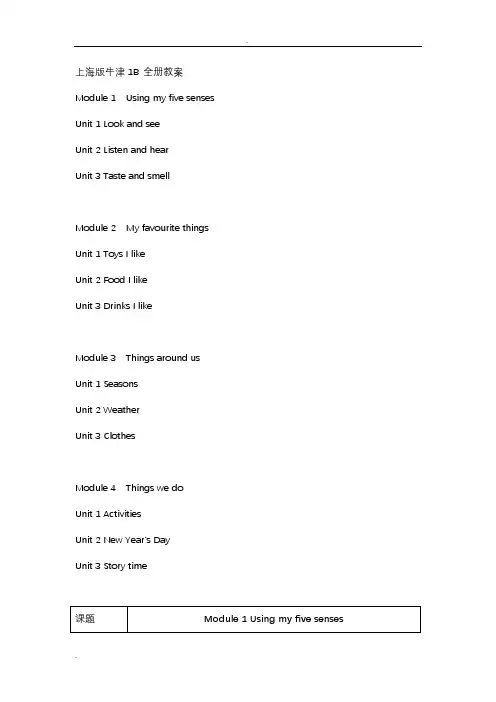
上海版牛津1B 全册教案Module 1 Using my five sensesUnit 1 Look and seeUnit 2 Listen and hearUnit 3 Taste and smellModule 2 My favourite thingsUnit 1 Toys I likeUnit 2 Food I likeUnit 3 Drinks I likeModule 3 Things around usUnit 1 SeasonsUnit 2 WeatherUnit 3 ClothesModule 4 Things we doUnit 1 ActivitiesUnit 2 New Year's DayUnit 3 Story time课题Module 1 Using my five sensesUnit 1 Look and seeLook and learn教学目标知识与技能:ing the new words in the context eg. frog, rabbit, bee, bird2.Asking wh-questions to find out what people seeeg. What do you see?ing formulaic expressions to indicate what peoplesee eg. I see…过程与方法:ing modeled phrases to communicatewith other studentsing modeled phrases to begin and maintain aninteraction by providing information in responseto factual questions教学重点和难点1.Identify the key words in an utterance byhearing the pronunciationeg. frog, rabbit, bee, bird2.Understand the meaning of wh-questionseg. What do you see?3.Understand the key patterneg. I am a ….教学媒体Pictures, masks, Cassette 1A, Cassette playerListening to the recording of the text.课前学生准备教学流程Pre-task preparation1.Warmerlisten to the song:<Good morning>Greetings2.Greetings.Good morning.Good afternoon.……T: Ask pupils to answer the teacher’s questions.While-task procedure1.IntroductionI see …Show a picture of a park to the students. Ask them what theysee.To elicit the structure:I see …(bird bee rabbit frog)2.Teach some new words.bird bee rabbit frog3.I’m a….Mime the small animals and let students guess what theanimals are.4.bird…Ask the students to say and mime the actions of the animals.One, two, three…I am a bee.…Teach the rhyme on Book P 2Post-task activity1.SubstitutionI am……Ask pupils to review the new sentences.Eg.A: One two three …B: I am a bee.A: Four , five.B: I am…板书设计frog rabbit bee birdI am a…教学效果的反馈课题Module 1 Using my five sensesUnit 1 Look and seeLook and say教学目标Language Focus:Using formulaic expressions to learn the phrases;Language Skill:Listening: Understand the meanings of wh-questionsSpeaking: Ask wh-questions to find out what people seeUse formulaic expressions to indicate what people see.教学重点和难点Understand the meaning of wh-questions eg. What do you see?eg. I see a ….教学媒体Pictures, masks, Cassette 1A, Cassette player课前学生准备Listening to the recording of the text.教学流程Pre-task preparation1.Show the words of the animals.bird rabbit bee….2.Ask; What do you see?I see….Are you a rabbit?Yes? No, I’m a …3.Divide the class into pairs. Ask tgen ti act as an animaland let the partner guess what animal it is.Are you a rabbit?4.Yes? No, I’m a …While-task procedurese the paper cut-outs. Show the students some parts ofthe small animals and ask them to guess what the animalsare. The students can play this guessing game in groups.What is it?It’s a bee.2.Ask the students to introduce each animal.It’s a…It’s …3.Have the students look at the pictures and practice inpairs.What do you see?I see…What colour is it?It’s…Post-task activitiesLet the student listen to the tape and repeat again and againThe workbookLet students do the practice in the workbook.板书设计What do you see?I see…What colour is it?It’s…教学效果的反馈课题Module 1Using my five sensesPlay a game教学目标Teaching Aims :1.Asking wh-question to fine out what people seeing formulaic expressions to indicate whatpeople seeing nouns to identify small animals.ing indefinite articles to refer to particularanimals.教学重点和难点1. Using the sentences: What do you see? What colour is it?2. Using formulaic expression to introduce the animals教学媒体Recorder and workbook ,picture cards课前学生Listening to the recording of the text.准备教学流程Pre-task preparation1.WarmerPs: Sing the song:Greetings2.Ask each student to make a mask of an animal. Ask them toput on their masks and make a dialogue with their partner.Hello. I am a bee. I am small.Hi , I am a frog. I am green.While-task procedure1.Show the students the wall pictures .2.Ask the students to listen to the dialogue.3.Elicit the key pattern What do you see? I see…T: What do you see?S;I see…4.Have the students look at the pictures and practice inpairs.What do you see?I see.What colour is it?It’s…5. Ask the students to play a game on book P5What do you see?I see.. It’s…Post-task activityLet’s playAsk the students to do Listen, colour and answer on workbookp4板书设计What do you see ? I see…What colour is it? It’s…教学效果的反馈课题Module1 Using my five sensesUnit 1 Listen and hearLook and say教学目标 ing the key words in context.ing imperatives give simple instructions eg: I hear…教学重点和难点1. STRUCTURES: sheep hen dog cat …2. FUNCTION: Using nouns to express animals’ noises.教学媒体pictures课前学生准备Listening to the recording of the text.教学流程I.Pre-task preparation:Warming up:Have the Ss listen to the song about the farm animals. Elicitthe new words nose, sheep,…II.While-task procedure:1.Prompt the Ss to repeat after you.Sheep hen dog cat…2.Teach a new chant about the animalsI hear…3.Ask the Ss to come to the front of the class and act asa puppet.4.Have the Ss to act all kinds of animals.III.Post-taskactivity:Ask the Ss to play a game What do you hear?.Have the Ss do exercisesIV.Assignment1.Listen to the tape.2.Read the words.3.Say the sentences..板书设计sheep hen dog catWhat do you hear?Oink, oink.I hear a pig.……教学效果的反馈课题 Module1 Using my five sensesUnit 1 Listen and hearSay and act教学目标 U 1.sing pronouns to refer to particular things.2.Understand the neaning of wh- questions.ing possessive adjectives to express possession. I hea教学重点和难点 S 1.TRUCTURES: What do you hear? I hear …2. 2.FUNCTION: Using: “I hear …” introduce the volicesLook It ’s you.教学媒体 pictures课前学生准备Listening to the recording of the text.教学流程 IV. Pre-task preparation:Warming up:1.(Review the words.)(1). Game:What do you hear?Say: I hear …V. While-task procedure:1.BingoHave the students listen several times to the song and actas different farm animals.2. Ask the students to play the game . Then let them say ingroups.I hear …I hear ….3. Divide the class into pairs. Ask one student to imitatethe sounds of farm animals and have the other one guessS1: Baa …Baa..S2: I hear a sheep.S1: Yes, it ’s a sheep.4.what the animal is.Learn the text on p 7VI.Post-taskactivity:1.Ask the students to do Part A “listen and number” on p6.Then have them practice in pairs.S1: Quack.. Quack…2.Have the students do Part C “ Listen, tick and answer” onbook p 7S2: I hear a duckIV.Assignment1.Listen to the tape.2. Read the sentences.板书设计What do you hear, Alice? Oink… oink…I hear …Oh, it’s you, ………教学效果的反馈课题Module1 Using my five sensesUnit 1 Listen and hear教学目标 ing the key words in context.ing imperatives give simple instructions eg: I he1.song: Bingo.教学重点和难点教学媒体Realia, tape.Listening to the recording of the text.课前学生准备教学流程VII.Pre-task preparation:1.Warming up:Rhyme: say some words about the farm animals.2.T: Say and actT: What do you hear?……II.While-task procedure:e the sounds animals make to elicit the key patternTeach a new chant about the animalsT: Miao…Miao… What do you hear?Ss: I hear a cat.6.Encourage the students to say a rhyme like the following,.The boys ask questions and the girls answerOink, oink.What do you hear?I hear a pig3. Listen to the song.< Bingo>and learn.Bingo.VIII.Post-taskactivity:Sing the song. BingoIV.Assignment1.Listen to the tape.2. sing the song.板书设计BingoThere was a farmer (who) had a dog.And Bingo was his name. Oh!教学效果的反馈课题Module1 Using my five sensesUnit 3 Taste and smell教学目标 ing nouns to identify food itemsing imperatives to give simple instructions教学重点和难点1.Sentence: Taste…Smell…2.Words: rice, soup, egg, noodles教学媒体Recorder and workbook ,picture cards课前学生准备Listening to the recording of the text.教学流程IX.Pre-task preparation:1.RhymePs: Read the Rhyme: <soup>2.Review the words of food1.Talk about the food:Eg This is an apple. It’s…I like …2.Review the dialogueMake a dialogue with their partner.--Can I help you?--May I have …--Here you are.--Thank you.II.While-task procedure:1. Teach: rice, noodlesShow the pictures and tell the students : Chinese like toeat rice and noodles2. Teach: eggDescribe the egg to elicit the wordTeach: Taste …Smell…Guess the wordsRead the word3.Have the students close their eyes and guess the names ofthe food by smelling and tastingClose their eyes and guessPost-taskactivity:Make the dialogueShow a menu and have the students make a dialogue.IV.AssignmentComplete the exercises板书设计Smell …Taste …教学效果的反馈课题Module1 Using my five sensesUnit 3 Taste and smellSay and act教学目标 ing nouns to identify food itemsing formulaic expressions to ask customer’spreferencesing formulaic expressions to offer people thingsing formulaic expressions to express thanks教学重点和难点Sentence: Can I help you?Here you are. Thank you.教学媒体Recorder and workbook ,picture cards课前学生准备Listening to the recording of the text.教学流程Pre-task preparation:1.Review the words: rice, noodles, soup, egg.Show the words of the food and students readRead the rhyme of the food2.Taste the noodles,Peter.Smell the soup, LindaAsk the more able students to act according to myinstructionsII.While-task procedure:1. 1.Dialogue:At the restaurantHave the students watch the flash and act out the dialogue.Ask the students to make the new dialogue with their deskmate2.Listen and enjoy.Have the students listen to and repeat after the rhymeHave them practice the rhyme several times with teacherPost-taskactivity:1.Let the student listen to the tape and repeat again andagain.2.Let students do the practice in the workbook板书设计Can I help you ?…,please.Here you are.Thank you.教学效果的反馈课题Module1 Using my five sensesUnit 3 Taste and smellPlay a game教学目标 ing nouns to identify food itemsing imperatives to give simple instructions教学重点和难点Sentence: Stand up. Touch your… Smell the…教学媒体Recorder and workbook ,picture cards课前学生准备Listening to the recording of the text.教学流程Pre-task preparation:1.Review the words: rice, noodles, soup, egg.Show the words of the food and students readRead the rhyme of the food2.Review the sentencesListen and act3.Dialogue:At the restaurantMake a dialogueII.While-task procedure:1.Play a game:Listen and actStand upTouch your…2.Guessing gameShow some foodLet the students close their eyes and smell the food3.Show a thingPost-taskactivity:1.Let the student listen to the tape and repeat again andagain.2.Let students do the practice in the workbook板书设计Stand upTouch…Smell…教学效果的反馈Module 2 My favourite thingsTask in this unit:●Begin an interaction by expressing one’s preferences●Begin an interaction by eliciting a responseLanguage focus:●Using nouns to identify toys: ball,doll,bicycle,kite●Using adjectivesto describe things: It’s super.●Using the definite article to indicate particular things: the ball,thedoll●Using formulaic expressions to offer people help: Can I help you?●Using formulaic expressions to offer people things: Here you are.●Using formulaic expressions to express thanks: Thank you.Language skills:Listening:●Identify the key words in an utterance by hearing the pronunciation:ball,doll,bicycle,kite●Understand the key pattern: I like…●Understand formulaic expressions to offer people things: Here you are.●Understand formulaic expressions to offer people help: Can I help you?Speaking:●Pronounce the words,phrases and sentences correctly:ball,doll,bicycle,kite●Use formulaic expressions to indicate preferences: I like…●Use formulaic expressions to offer people things: Here you are.●Use formulaic expressions to express thanks: Thank you.●Use adjectivesto describe things: It’s super.Use formulaic expressions to offer people help: Can I help you?Scheme of work:Period Core contents Extension Materials Grammar andexpressionsVocabulary1 I like…ball,doll,bicycle,kite SB:pp.14 ,15 WB:pp.14,15, Parts A,B,C2 I like…nice superYou like…SB:pp.15,16,17 WB:pp.16,17 Part D and TaskModule2 / Unit 1 / Period 1Aims:1. Words: ball,doll,bicycle,kite2.Function: Use formulaic expressions to indicate preferences: I like…Language focus:1. Pronounce the words,phrases and sentences correctly2. Understand the key pattern: I like…Aids: Pictures, Realia, tape.PROCEDRES CONTENTS METHODS PURPOSEI.Pre-task preparation Warming up:Song Sing a song.通过歌曲引出今天的教学。
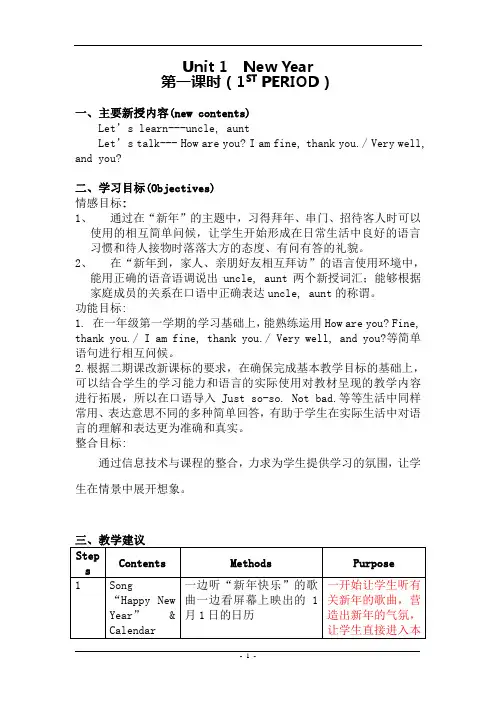
Unit 1 New Year第一课时(1ST PERIOD)一、主要新授内容(new contents)Let’s learn---uncle, auntLet’s talk--- How are you? I am fine, thank you./ Very well, and you?二、学习目标(Objectives)情感目标:1、通过在“新年”的主题中,习得拜年、串门、招待客人时可以使用的相互简单问候,让学生开始形成在日常生活中良好的语言习惯和待人接物时落落大方的态度、有问有答的礼貌。
2、在“新年到,家人、亲朋好友相互拜访”的语言使用环境中,能用正确的语音语调说出uncle, aunt两个新授词汇;能够根据家庭成员的关系在口语中正确表达uncle, aunt的称谓。
功能目标:1. 在一年级第一学期的学习基础上,能熟练运用How are you? Fine, thank you./ I am fine, thank you./ Very well, and you?等简单语句进行相互问候。
2.根据二期课改新课标的要求,在确保完成基本教学目标的基础上,可以结合学生的学习能力和语言的实际使用对教材呈现的教学内容进行拓展,所以在口语导入Just so-so. Not bad.等等生活中同样常用、表达意思不同的多种简单回答,有助于学生在实际生活中对语言的理解和表达更为准确和真实。
整合目标:通过信息技术与课程的整合,力求为学生提供学习的氛围,让学生在情景中展开想象。
猜而直接提示:This is father’s sister. 引入aunt把语音和语义同时输入给学生。
aunt的机械性操练也可以先全体跟着教师朗读。
其中开始一两遍可以是正常声音升降调跟读,接着可以由响到轻或由轻到响地跟读。
旨在通过跟读音调的变化既达到反复模仿上口,又减少机械模仿的枯燥。
Unit 1 New Year第二课时(2nd PERIOD) 一.要新授内容(new contents)Let’s learn---grandmother, grandfather Let’s talk----Happy New Year!二.主要目标(Objectives)情感目标:1.通过“新年”这个主题,使学生学会用新年特定的问候语Happy NewYear与家人或客人相互问候,让学生在日常生活中养成良好的语言习惯及文明习惯。

教案学科:英语年级:一年任课教师:***学期:2012—2013学年度下学期学校:乐山镇中心小学校学生名册课程表“学科生命教育”课堂基本要素1、教师要树立“关爱生命、尊重人格、关注尊严、学生是学习的主体、学生是学习的主人”的理念,精心设计教学目标、教学内容、教学重点,深入挖掘教学内容中的生命教育因素,打造充满生命互动的课堂,使学生获得精神上的满足,使师生在相互作用中进行智慧的碰撞、情感的交融和心灵的沟通,使教学目标得到创造性的实现。
2、教师要用火热的激情调动与激发学生的学习热情和学习状态,通过恰当的教学方式和教学手段,积极构建温暖、和谐、平等的课堂氛围,以情融教,情景交融;以乐激教,快乐无限,使课堂焕发出生命的活力。
3、尊重学生的生命自由、生命差异,因材施教,尽量满足不同层次学生对知识的需求,引导学生正确理解和认识生命的意义。
4、倡导自主、合作、探究学习方式,爱护学生的好奇心、求知欲,努力为学生创造展示自己的机会,搭建展示的平台,鼓励学生在公众面前充分展示自己的学习成果和聪明才智。
5、在课堂教学过程中,让学生体验到自由、尊重、信任、友善、理解、关爱和亲情,受到激励、鞭策、感化和鼓舞,形成积极的人生态度和乐观的生命情感。
6、课堂上实施激励、明理式的评价,要以肯定、表扬、鼓励为主,让学生在“成功中体会快乐,在快乐中实现幸福”。
教学进度表(英语)课标要求听做:1、能根据听到的词语识别或指认图片或实物;2、能听懂课堂简短的指令并做出相应的反应;3、能根据指令做事情,如:指图片、涂颜色、画图、做动作、做手工等;4、能在图片和动作的提示下听懂简单的小故事并做出反应。
说唱:1、能根据录音模仿说英语;2、能相互致以简单的问候;3、能相互交流简单的个人信息,如:姓名、年龄等;4、能表达简单的情感和感觉,如:喜欢和不喜欢;5、能够根据表演猜测意思、说词语,6、能唱英语儿童歌曲15一20首,说歌谣15一20首;7、能根据图、文说出单词或短句。
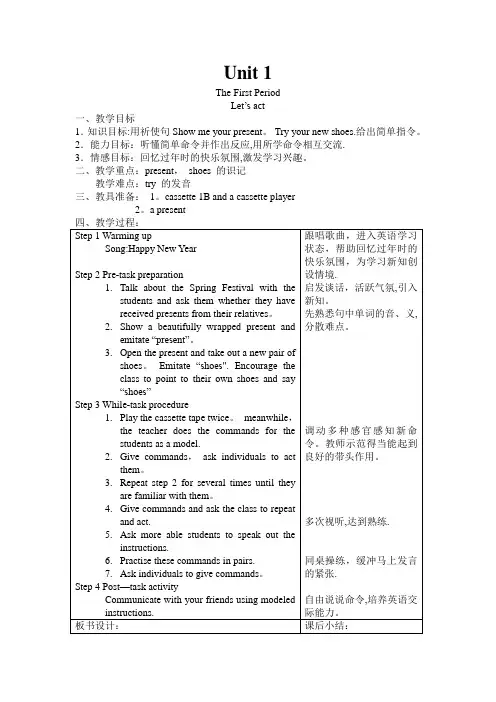
Unit 1The First PeriodLet’s act一、教学目标1.知识目标:用祈使句Show me your present。
Try your new shoes.给出简单指令。
2.能力目标:听懂简单命令并作出反应,用所学命令相互交流.3.情感目标:回忆过年时的快乐氛围,激发学习兴趣。
二、教学重点:present,shoes 的识记教学难点:try 的发音三、教具准备:1。
cassette 1B and a cassette player2。
a presentThe Second PeriodLet’s talk一、教学目标:1.知识目标:学会Happy New Year 问候新年好.学会问候语How are you?及两种不同回答:I am fine. Thank you; Very well,and you?2.能力目标:能熟练运用这些句子交流自如.3.情感目标:教育学生要有礼貌问候别人。
二、教学重点:How are you 及Happy New Year 问候语。
三、教学难点:Very well 的正确发音。
四、教具准备:Cassette 1 B and Cassette player,Wallcharts 1 B and a puppet。
The Third PeriodLet’s learn一、教学目标:1.知识目标:会用uncle,aunt,grandmother,grandfather 称呼人。
2.能力目标:培养正确、快速模仿能力.3.情感目标:教育学生尊敬长辈。
二、教学重点:4个人称的正确发音。
教学难点:单词词形的识记。
三、教具准备:cassette 1B and cassette player,wallchart,word cardsThe Fourth PeriodLet’s play一、教学目标:1.知识目标:学会用draw,write,fold 说出制作贺卡过程.2.能力目标:正确模仿发音并根据指令作出相应反应。
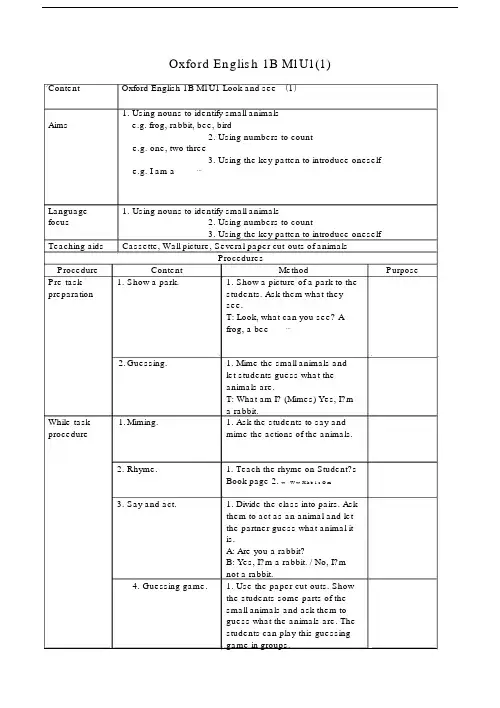
Oxford English 1B M1U1(1)Content Oxford English 1B M1U1 Look and see(1)1. Using nouns to identify small animalsAims e.g. frog, rabbit, bee, bird2. Using numbers to counte.g. one, two three3. Using the key patten to introduce oneselfe.g. I am a⋯Language 1. Using nouns to identify small animalsfocus 2. Using numbers to count3. Using the key patten to introduce oneself Teaching aids Cassette, Wall picture, Several paper cut-outs of animalsProcedure Content ProceduresMethod PurposePre-task 1. Show a park. 1. Show a picture of a park to the preparation students. Ask them what theysee.T: Look, what can you see? Afrog, a bee ⋯2. Guessing. 1. Mime the small animals andlet students guess what theanimals are.T: What am I? (Mimes) Yes, I?ma rabbit.While-task 1. Miming. 1. Ask the students to say and procedure mime the actions of the animals.2. Rhyme. 1. Teach the rhyme on Student?sBook page 2. w W w .X k b 1.c O m3. Say and act. 1. Divide the class into pairs. Askthem to act as an animal and letthe partner guess what animal itis.A: Are you a rabbit?B: Yes, I?m a rabbit. / No, I?mnot a rabbit.4. Guessing game. 1. Use the paper cut-outs. Showthe students some parts of thesmall animals and ask them toguess what the animals are. Thestudents can play this guessinggame in groups.Post-task activityA:What is it?B:It?s a bee.1.Make a mask and a 1. Ask each student to make a dialogue.mask of an animal.2.Ask them to put on their masksand make a dialogue with theirpartner.A: Hello. I am a bee. I am small.B: Hi, I am a frog. I am green. 2. Act the rhyme. 1. Ask the students to say and actthe rhyme on page 2.3. Listen and tick. 1. Ask the students to do Part A?Listen and tick? on Workbookpage 2. Then have them work inpairs to introduce each animal.A: It?s a w ⋯W w .x K b 1.c o MB: It?s a ⋯板4. Act and guess.Unit 1 Look and seeseebeebird1.Have the students do PartB ,Act and guess? on Workbookpage 3 and then ask them to doan activity like this in groups.复上学期英字母,是本学期开始的关教。
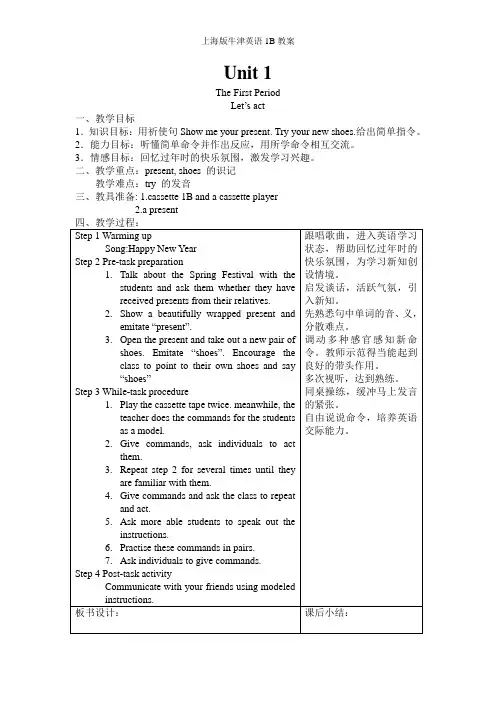
Unit 1The First PeriodLet’s act一、教学目标1.知识目标:用祈使句Show me your present. Try your new shoes.给出简单指令。
2.能力目标:听懂简单命令并作出反应,用所学命令相互交流。
3.情感目标:回忆过年时的快乐氛围,激发学习兴趣。
二、教学重点:present, shoes 的识记教学难点:try 的发音三、教具准备: 1.cassette 1B and a cassette player2.a presentThe Second PeriodLet’s talk一、教学目标:1.知识目标:学会Happy New Year 问候新年好。
学会问候语How are you?及两种不同回答:I am fine. Thank you; Very well, and you?2.能力目标:能熟练运用这些句子交流自如。
3.情感目标:教育学生要有礼貌问候别人。
二、教学重点:How are you 及Happy New Year 问候语。
三、教学难点:Very well 的正确发音。
四、教具准备:Cassette 1 B and Cassette player, Wallcharts 1 B and a puppet.The Third PeriodLet’s learn一、教学目标:1.知识目标:会用uncle, aunt, grandmother, grandfather 称呼人。
2.能力目标:培养正确、快速模仿能力。
3.情感目标:教育学生尊敬长辈。
二、教学重点:4个人称的正确发音。
教学难点:单词词形的识记。
三、教具准备:cassette 1B and cassette player, wallchart, word cardsThe Fourth PeriodLet’s play一、教学目标:1.知识目标:学会用draw, write, fold 说出制作贺卡过程。
上海版牛津 1B 全册教案Module 1 Using my five senses Unit 1 Look and seeUnit 2 Listen and hearUnit 3 Taste and smellModule 2 My favourite things Unit 1 Toys I likeUnit 2 Food I likeUnit 3 Drinks I likeModule 3 Things around us Unit 1 SeasonsUnit 2 WeatherUnit 3 ClothesModule 4 Things we doUnit 1 ActivitiesUnit 2 New Year's DayUnit 3 Story timeTask in this unit:●Begin an interaction by expressing one’s preferences●Begin an interaction by eliciting a responseLanguage focus:●Using nouns to identify toys: ball,doll,bicycle,kite●Using adjectivesto describe things: It’s super.●Using the definite article to indicate particular things: the ball,the doll●Using formulaic expressions to offer people help: Can I help you?●Using formulaic expressions to offer people things: Here you are.●Using formulaic expressions to express thanks: Thank you.Language skills:Listening:●Identify the key words in an utterance by hearing the pronunciation:ball,doll,bicycle,kite●Understand the key pattern: I like…●Understand formulaic expressions to offer people things: Here you are.●Understand formulaic expressions to offer people help: Can I help you? Speaking:●Pronounce the words,phrases and sentences correctly: ball,doll,bicycle,kite ●Use formulaic expressions to indicate preferences: I like…●Use formulaic expressions to offer people things: Here you are.●Use formulaic expressions to express thanks: Thank you.●Use adjectivesto describe things: It’s super.●Use formulaic expressions to offer people help: Can I help you?Module2 / Unit 1 / Period 1Aims:1.Words: ball,doll,bicycle,kite2.Function: Use formulaic expressions to indicate preferences: I like…Language focus:1.Pronounce the words,phrases and sentences correctly2.Understand the key pattern: I like…Aids: Pictures, Realia, tape.Module 2 / Unit 1 /Period 2Aims:1. Use formulaic expressions to offer people things: Here you are.e formulaic expressions to express thanks: Thank you.e adjectivesto describe things: It’s super.e formulaic expressions to offer people help: Can I help you? Language focus:1.Understand formulaic expressions to offer people things: Here you are.2.Understand formulaic expressions to offer people help: Can I help you? Aids: Pictures, Realia, tape.Module 2 / Unit 1 /Period 3Aims:1.Review the words: ball,doll,bicycle,kite2.Review the sentences: I like …3.Drills: I like the ….Language focus:Use formulaic expressions to indicate preferences: I like the… Aids: Pictures, Realia, tape.教学效果反馈Module 2 My favourite thingsUnit 2 Food I likeTasks in this unit1.Begin an interaction by introducing one’s preferences2.End an interaction by using simple formulaic expressions3.Begin an interaction by eliciting a responseLanguage focusing nouns to identify foodeg. jelly, ice, cream, sweet, biscuiting formulaic expressions to indicate preferencese.g. I like ice cream.3.Asking yes/no questions to find out one’s preferencese.g. Do you like,…?ing formulaic expressions to confirm or denye.g. Yes./No.ing formulaic expressions to offer people thingse.g. One for you.Learning skills:Listening5.Identify the key words in an utterance by hearing the pronunciationeg. jelly, ice, cream, sweet, biscuit6.Identify specific information in response to questionse.g. Do you like sweets? No.3. Understand formulaic expressions indicating preferencese.g. I like ice cream.Speaking1.Identify the key words in an utterance by hearing the pronunciationeg. jelly, ice, cream, sweet, biscuiting formulaic expressions to indicate preferencese.g. I like …3.Asking yes/no questions to find out one’s preferencese.g. Do you like,…?ing formulaic expressions to confirm or denye.g. Yes./No.ing formulaic expressions to offer people thingse.g. One for you.The first PeriodAims:1. Words: jelly, ice, cream, sweet, biscuit6. Function: Use formulaic expressions to indicate preferences: I like…Language focus:1.Pronounce the words, phrases and sentences correctlye.g. jelly, ice, cream, sweet, biscuit2.Understand the key pattern: I like…Aids: Pictures, Radio, tape.The second PeriodAims:1.Words: jelly, ice, cream, sweet, biscuit2.Sentences: Do you like …?Yes./No.One for you and one for me.Function:1.Asking yes/no questions to find out one’s preferencese.g. Do you like,…?ing formulaic expressions to confirm or denye.g. Yes./No.Language focus:1.Asking yes/no questions to find out one’s preferencese.g. Do you like,…?ing formulaic expressions to confirm or denye.g. Yes./No.Aids: Pictures, Radio, tape.The third periodA:Contents :Sentence: One for you and one for you.B:Teaching Aims :Using formulaic expressions to offer people thingse.g. One for you.C:Teaching aids :Recorder and workbook ,picture cardsTasks in this unit: Module 2 My favourite things Unit 3 Drinks I like●Begin an interaction by introducing one’s preferences●End an interaction by using simple formulaic expressions●Begin an interaction by eliciting a responseLanguage focus:●Using nouns to identify drinks: cola,juice,milk,water●Using imperatives to give simple instructions: Drink some milk,Sam.●Using the indefinite determiner some to show quantity: Drink some water,Mum.●Asking wh-questions to ask for specific information about a person: What do youlike?●Using the simple present tense to express preferences: I like water.●Using formulaic expressions to wish someone a happy birthday: HappyBirthday,Eddie.Language skills:Listening:●Identify specific information in simple instructions: Drink some milk,Sam.●Identify the key words by hearing the pronunciation: cola,juice,milk,water●Identify specific information in response to simple questions: What do you like?Ilike water.●Understand formulaic expressions wishing someone a happy birthday: HappyBirthday,Eddie.Speaking:●Pronounce the words,phrases and sentences correctly: cola,juice,milk,water●Using imperatives to give simple instructions: Drink some milk,Sam.●Asking wh-questions to ask for specific information about a person: What do youlike?●Use the key pattern to express preferences: I like water.●Use adjectivesto describe things: It’s super.●Use formulaic expressions to wish someone a happy birthday: HappyBirthday,Eddie.Drinks I likeThe First PeriodAims:1.Words: cola,juice,milk,water2.Function: Use specific information in response to simple questions: What do you like? Ilike…Language focus:1.Pronounce the words,phrases and sentences correctly2.Identify specific information in response to simple questions: What do you like? Ilike…Aids: Pictures, Realia, tape.Drinks I likeThe Second PeriodAims:e imperatives to give simple instructions: Drink some milk,Sam.2.Ask wh-questions to find out one’s preferences: What do you like?e the key pattern to express preferences: I like water.Language focus:ing imperatives to give simple instructions: Drink some milk,Sam.2.Asking wh-questions to find out one’s preferences: What do you like?ing the verb like to indicate preferences: I like water.Aids: Pictures, Realia, tape.Drinks I likeThe Third PeriodAims:1.Review the words: birthday,cola,juice,milk,water2.Review the sentences: What do you like? I like water(milk, cola,juice).e formulaic expressions to wish someone a happy birthday: Happy Birthday,Eddie. Language focus:Using formulaic expressions to wish someone a happy birthday: HappyBirthday,Eddie.Aids: Pictures, Realia, tape.Tasks in this unit: Module 4 Things we do Unit 2 New Year’s DayBegin an interaction and maintain it by responding to questions Using modeled phrases to communicate with other students.Use formulaic expressions to offer people thingsLanguage focus:Using nouns to identify objects e.g.,gift, card, firework, firecrackerUsing imperatives to give instructionse.g., Draw. Write. Fold.Using adjectives to describe thingse.g., newUsing formulaic expressions to greet people on New Year’s Daye.g., Happy New Year!Using formulaic expressions to offer people thingse.g., A gift for you.Using the simple present tense to express interest and preferencese.g., I like the red dress.Language skills:ListeningIdentify specific information in response to simple instructionse.g., draw, write, foldUnderstand the key patterne.g., I like the red dress.Identify the key words in an utterance by hearing the pronunciation e.g., gift, card, firework, firecrackerunderstand formulaic expressions of New Year’s greetingse.g., Happy New Year!Understand formulaic expressions offering people thingse.g., A gift for you.Understand a simple story with the help of pictures and body language SpeakingPronounce the words, phrases and sentences correctlye.g., gift, card, firework, firecrackerUse imperatives to give instructionse.g., Draw. Write. Fold.Use formulaic expression to greet peoplee.g., Happy New Year, Miss Fang.Use the pattern I like the … to express interests and preferences e.g., I like the sweets.Use formulaic expressions to offer people thingse.g., A gift for you.Use formulaic expressions to express thankse.g., Thank you.Period 1Language focus:Using nouns to identify objects e.g.,gift, card, firework, firecrackerUsing formulaic expressions to greet people on New Year’s Day e.g., Happy New Year!Using formulaic expressions to offer people thingse.g., A gift for you.Language skills:ListeningIdentify the key words in an utterance by hearing the pronunciation e.g., gift, firework, card, firecrackerUnderstand formulaic expressions of greetingse.g., Happy New Year!Understand formulaic expressions offering people thingse.g., A gift for you.Understand the meaning of the song.SpeakingPronounce the words, phrases and sentences correctly e.g., firecracker, gift, firework, cardUse formulaic expressions of greetingse.g., Happy New Year!Use formulaic expressions to offer people thingse.g., A gift for you.Use formulaic expressions to express thankse.g., Thank you.Sing the song and act it outMaterials:Student’s Book 1B, pp.42 and 45Workbook 1B, p.42, Part ACassette 1BWall picture 1BFlashcards 1B (gift, card, firework, firecracker)M4 Unit 2 New Year’s Daygift Happy New Year! card Happy New Year! firecracker A gift for you, …. firework Thank you. Exercise:Act out the dialogue with your classmates.。
小学英语年级上海版牛津英语1b教案全册Unit 1The First PeriodLet’s act一、教学目标1.知识目标:用祈使句Show me your present. Try your new shoes.给出简单指令。
2.能力目标:听懂简单命令并作出反应,用所学命令相互交流。
3.情感目标:回忆过年时的快乐氛围,激发学习兴趣。
二、教学重点:present, shoes 的识记教学难点:try 的发音三、教具准备: 1.cassette 1B and a cassette player2.a presentRevision II. Teaching Contents: Unit 1—Unit 3II. Teaching Aims: 1、能听说和辨认单词2、能运用已学句型进行对话交流III. Difficult Points: 1、单词的认读2、句型:I see .How many ?Is it (colour) ?IV. Teaching Aids: some pictures, word cards, tape recorder, OHPV. Teaching Procedure:一、Warming up1. Sing a song <Ten little paper rabbits>Warming upSong: Do you like…Step 2 Pre-task preparation1. Show a box of sweets. Pick a sweet and say “What is it? Sweet.” Repeat.2. Point to the box of sweets and say “I like the sweets.” Students point to the box of s weets and repeat.3. Show picture cards for “shoes” and “dress” to the class and say “I like the new shoes.I like the new dress.” Stu dents repeat.Step 3 While-task procedure1. Show a wallchart of page 6. Tell a story about this.2. Play the cassette tape of page 6. Students listen.1PS:双击获取文档,ctrl+a,ctrl+c,然后粘贴到word即可。
—-可编辑修改,可打印——别找了你想要的都有!精品教育资料——全册教案,,试卷,教学课件,教学设计等一站式服务——全力满足教学需求,真实规划教学环节最新全面教学资源,打造完美教学模式教学进度表(英语)课标要求听做:1、能根据听到的词语识别或指认图片或实物;2、能听懂课堂简短的指令并做出相应的反应;3、能根据指令做事情,如:指图片、涂颜色、画图、做动作、做手工等;4、能在图片和动作的提示下听懂简单的小故事并做出反应。
说唱:1、能根据录音模仿说英语;2、能相互致以简单的问候;3、能相互交流简单的个人信息,如:姓名、年龄等;4、能表达简单的情感和感觉,如:喜欢和不喜欢;5、能够根据表演猜测意思、说词语,6、能唱英语儿童歌曲15一20首,说歌谣15一20首;7、能根据图、文说出单词或短句。
玩演:1、能用英语做游戏并在游戏中用英语进行简单的交际;2、能做简单的角色表演;3、能表演英文歌曲及简单的童话剧,如(小红帽)等。
读写:1、能看图识字;2、能在指认物体的前提下认读所学词语;3、能在图片的帮助下读懂简单的小故事;视听:1、能看懂语言简单的英语动画片或程度相当的教学节目;2、视听时间每学年不少于10小时(平均每周20一25分钟)。
牛津英语1B教材分析教材分析:1.本套教材注重听说训练,着重培养学习的语感和初步用英语进行简单日常交流的能力;并通过听、说、读、写、唱、游、演、画、做等活动激发学生的学习兴趣,帮助学习养成良好的学习习惯,形成有效的学习方法,发展自主学习的能力,为进一步学习打下基础。
2.按“话题--功能--结构--任务”相结合的原则编写,并力求使话题、功能、结构和任务四个方面在比较真实的情景中紧密联系,融为一体。
3.内容贴近学生的生活和学习实际,并配有大量生动活泼、富有情趣的插图,以利于学生比较接近于实际的情景中进行听说训练,也为教师组织教学活动提供方便。
本学期采用的教材为牛津英语(上海版)一年级第一学期1B.全册教材共有三个主题九个单元,分别为:Theme 1: SpringUnit 1: New YearUnit 2: Small animalsUnit 3: ColoursTheme 2: People who help usUnit 4: Postman and policemanUnit 5: Doctor and nurseUnit 6: Farmer and fishermanTheme 3: Food and drinkUnit 7: Birthday partyUnit 8: DinnerUnit 9: Revision教学目标:在这个学期中要求学生达到的也就是本学期的教学的总的目标是:1.要求学生很扎实的掌握好书本的各个知识点。
矿产资源开发利用方案编写内容要求及审查大纲
矿产资源开发利用方案编写内容要求及《矿产资源开发利用方案》审查大纲一、概述
㈠矿区位置、隶属关系和企业性质。
如为改扩建矿山, 应说明矿山现状、
特点及存在的主要问题。
㈡编制依据
(1简述项目前期工作进展情况及与有关方面对项目的意向性协议情况。
(2 列出开发利用方案编制所依据的主要基础性资料的名称。
如经储量管理部门认定的矿区地质勘探报告、选矿试验报告、加工利用试验报告、工程地质初评资料、矿区水文资料和供水资料等。
对改、扩建矿山应有生产实际资料, 如矿山总平面现状图、矿床开拓系统图、采场现状图和主要采选设备清单等。
二、矿产品需求现状和预测
㈠该矿产在国内需求情况和市场供应情况
1、矿产品现状及加工利用趋向。
2、国内近、远期的需求量及主要销向预测。
㈡产品价格分析
1、国内矿产品价格现状。
2、矿产品价格稳定性及变化趋势。
三、矿产资源概况
㈠矿区总体概况
1、矿区总体规划情况。
2、矿区矿产资源概况。
3、该设计与矿区总体开发的关系。
㈡该设计项目的资源概况
1、矿床地质及构造特征。
2、矿床开采技术条件及水文地质条件。